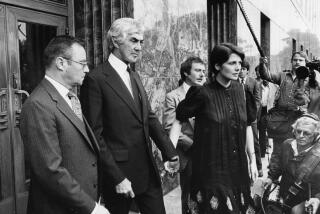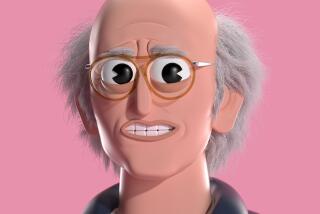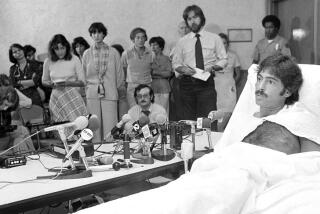‘60s Drug Guru Timothy Leary Dies at 75
Timothy Leary, the Harvard psychologist whose advocacy of mind-altering drugs and defiance of the status quo made him an icon of the psychedelic 1960s and, in President Richard Nixon’s words, “the most dangerous man in America,” died early Friday at his Beverly Hills home.
He was 75 and had disclosed last year that he had inoperable prostate cancer.
Leary had wanted to meet death on his own terms, declaring that he planned to commit suicide and have it broadcast worldwide on the Internet. But the illness overtook him in his last weeks, and he was unable to carry out what would have been his final act of defiance. He did, however, request that his ashes be shot into space.
His last coherent words came about six hours before he died.
“Why?” Leary suddenly blurted out. There was a long, silent pause, and then he said, much more softly, “Why not?”
At his bedside when he died were about 20 friends, his stepson Zach Leary, and his third wife, Rosemary Woodruff Leary--they had divorced but remained close.
It was a quiet end for a man whose scholarly explorations into the effects of hallucinogenic drugs--especially LSD--caused a social explosion that propelled him to hero status among those who embraced drugs as a symbol of rebellion.
“Turn on. Tune in. Drop out,” he urged the 1960s flower children, who bestowed upon him the adulation usually reserved for rock stars. But much of the older set--who believed he was leading a generation of Americans astray--agreed that he was indeed dangerous.
Leary relished both roles. Starting early in life, he delighted in tweaking conventional wisdom, using humor and his charisma as a speaker as his main weapons. His life mirrored the eras in which he lived, even while he raged against them.
“He was some kind of Zelig among the Zeitgeist,” said his friend John Perry Barlow, a writer and activist on Internet issues. “Whatever was going on in the culture, it was something he could not help to emulate.
“In the ‘40s he was a cadet at West Point, in the ‘50s he was a tweedy college professor, in the ‘60s he was Timothy Leary, which was exactly right for that time,” Barlow said. “In the ‘70s he was a political prisoner and in the ‘80s he lived in Beverly Hills and hung out at Spago. He found a place in whatever was going on around him.”
Timothy Francis Leary was born in Springfield, Mass., in 1920, the only child of an Army captain and a woman who counted among her friends Gen. Douglas MacArthur. Following the family tradition, Leary entered the U.S. Military Academy at West Point in 1940.
He soon became embroiled in a controversy over a drinking party on a troop train, openly confessing his participation. Under pressure, he left the academy in 1941.
That year, he decided to become a psychologist, “because, at the time, this profession appeared to be the sensible, scientific way of dealing with the classic human predicaments of boredom, ignorance, suffering and fear,” he later wrote.
It didn’t take him long to challenge the tenets of that field. While a graduate student at UC Berkeley, Leary questioned accepted theories of personality.
“He believed what people called abnormal was really just an exaggeration of normal personality,” said University of British Columbia psychologist Jerry Wiggans, who studied Leary’s early work.
Leary’s 1957 book, “The Interpersonal Diagnosis of Personality,” was declared the year’s “most important book on psychology” by the Annual Review of Psychology.
As he rapidly moved up in his field, his personal life was in turmoil. On his birthday in 1955, he and his two small children discovered his wife in their car, locked inside the garage with the motor running.
“I don’t think Tim ever really got over his wife’s suicide,” said Steven Strack, a Los Angeles psychologist who organized a 1994 American Psychological Assn. tribute to Leary. “I’m not sure his family life ever recovered.”
Leary joined the faculty at Harvard’s Center for Personality Research in 1959.
“Tim in many ways is still that 1950s-type professor,” his close friend Vicki Marshall said a few months before he died. “He’s a bit of a chauvinist, he likes to engage people in discussions and he likes to be in control of what’s going on around him.”
But the seemingly stereotypical professor again took on the establishment. He wasn’t content to simply study personality, he wanted to discover a way to change it.
On a trip to Mexico in 1960, an anthropologist suggested that Leary ingest a fungus popularly known as “magic mushrooms.”
“I gave way to delight as mystics have for centuries when they peeked through the curtains and discovered that this world--so manifestly real--was actually a tiny stage set constructed by the mind,” he later wrote in “Flashbacks,” his 1983 autobiography.
“I learned that . . . consciousness and intelligence can be systematically expanded. That the brain can be reprogrammed.”
Upon returning to Harvard, Leary began a series of experiments in which his subjects, including students, took psilocybin and later LSD. As word spread about his work, Leary was sought out by Bohemian and literary luminaries, some of whom had already tried psychedelics.
Aldous Huxley, Allen Ginsberg, Robert Lowell, Arthur Koestler, William Burroughs, Jack Kerouac and Neal Cassady all participated in experiments with Leary.
With these well-known people involved--Ginsberg declared that world conflict would end if only President John F. Kennedy and Soviet Premier Nikita Khrushchev would take LSD together--public interest in the drugs grew rapidly.
Leary began traveling and lecturing widely, his credibility boosted by his Harvard credentials. He enjoyed his first brushes with Hollywood-style celebrity. In his autobiography he wrote about a drug experience with Marilyn Monroe and chats with Cary Grant.
At the same time, he knew a backlash was simmering.
“This control of the mind through drugs, which we call internal politics, will be the leading civil liberties issue in the coming decades,” he said during a 1962 visit to Los Angeles.
He didn’t have to wait that long.
Back at Harvard, a group of faculty members already was criticizing Leary’s work, saying LSD and similar drugs should be administered only by physicians in medical settings. Even scientists who had applauded his pre-drug work questioned Leary’s assertion that LSD could be used to change personality traits.
Rather than back off, Leary proclaimed that taking LSD was a “sacramental ritual” and continued to fervently promote its use to expand consciousness.
By 1963, his relationship with the university had reached the breaking point. Harvard, which had rarely let a professor go in its long history, fired him. The official reason was that he had failed to show up for classes. Leary called it “a phony rap.”
On Friday, Harvard officials declined to make any comment about Leary other than to confirm that he once worked there and to reissue a one-sentence, 1963 statement that said the university had moved “to relieve him from further teaching duty and to terminate his salary as of April 30, 1963.”
His termination by Harvard only elevated his standing in what came to be known as the counterculture. As the hippie movement grew, his presence became a staple at major events, including concerts and giant “love-in” gatherings--featuring music, light shows and the flouting of drug laws--that he helped organize.
He grew close to novelist Ken Kesey’s “merry pranksters” and many of the best-known bands of the era. The Moody Blues recorded a song about him, and Jimi Hendrix accompanied his chants on an album. He was one of the chosen few to sit at the Montreal hotel room bedside of John Lennon and Yoko Ono to sing along on “Give Peace a Chance.”
Ever-smiling in public, he preached about the “contagious nature of optimistic interactions” and he described himself as a “hope fiend.” But his friend and Harvard colleague, psychologist Richard Alpert (who later took the name Ram Das), said Leary in private could be autocratic and stubborn in his refusal to deal with real-world issues.
In 1966, Leary appeared before a Senate committee to urge “legislation which will license responsible adults to use psychedelic drugs for serious purposes.”
But many took LSD for a mental thrill ride. Reports arose of young people having “bad trips” and behaving in a bizarre manner. There were reports of suicides and fatal accidents. Leary became the most visible target for anti-drug forces. And be began to run afoul of the law.
He was charged with smuggling a small amount of marijuana into the country from Mexico in 1965. A local lawyer advised him to take a plea bargain, but Leary was intent on using the trial as a forum to question the validity of drug laws. On the stand in Laredo, Texas, he declared that he had a right as a scientist and a Hindu to use marijuana in research and as a sacrament.
His sentence: 30 years and $30,000.
The smuggling conviction was overturned, but on retrial he was sentenced to 10 years for possession by a judge who called him a “menace to the country.”
More appeals followed, as did arrests. In 1966, G. Gordon Liddy, later of Watergate fame, was on hand for a drug-related Leary arrest in Dutchess County, N.Y., where Liddy was an assistant district attorney. Leary avoided jail until 1970, when he was sent to the state prison in San Luis Obispo, facing up to 20 years for two possession convictions.
He had no trouble negotiating the personality test the prison psychologist administered--it was based on Leary’s own work in the 1950s.
On a moonless night in September 1970, he shimmied across a telephone line to the other side of the prison fence. A waiting car--arranged by the radical Weathermen underground movement, according to news reports and his autobiography--whisked him away, and he was smuggled out of the country.
Leary became the guest of the Black Panthers in Algeria until he fell into disfavor with that group. He moved from country to country, trying to find a nation that would grant him asylum. In 1973, he was detained while trying to enter Afghanistan and was sent back to the United States.
Leary was returned to prison, this time in Folsom, and at one point was placed in a cell across from Charles Manson. He was released on parole in 1976.
The flower children now were parents and wage earners. Leary was more of a curiosity, an object of nostalgia for the recent past. People magazine did a photo feature on him.
He began lecturing again and joined a number of ventures, including developing a self-analysis software program called Mind Mirror. But Leary rarely stuck with projects long enough to complete them.
Settling in Beverly Hills in the late 1970s, Leary made numerous friends in the filmmaking community and soon became a fixture at Hollywood parties and premieres. He had bit parts in several minor movies. More successful was a debating tour with his former nemesis Liddy.
His personal life was marked by tragedy and broken relationships. In 1990, his daughter, Susan, 42, was in custody at the Sybil Brand Institute, having been found mentally unfit to stand trial for shooting her sleeping boyfriend. That year, she used her shoelaces to hang herself from the bars of her cell.
In January 1995, Leary called his closest friends to tell them he had cancer. In interviews, he said he welcomed this “third act” of his life.
Leary met several months ago with his son, Jack, whom he had not seen in several years. But the reunion was brief. People close to both of them say Jack felt he had been deserted by his father at a critical time in his life.
In his final year, Leary surrounded himself mostly with people under 30, several of whom were paid a salary to attend to his needs and work on a World Wide Web site on the Internet that would keep his legacy alive.
He raised money by charging fees to some of the magazines and video outfits that came to interview him. The going rate was $1,000 an hour.
Three weeks before he died he abandoned his long-held plans to have his head frozen in “cryonic suspension” in the hope he could be thawed and revived in the future. After his falling-out with cryonics supporters, he complained: “They have no sense of humor. I was worried I would wake up in 50 years surrounded by people with clipboards.”
Even though he joked about death, “he is as afraid of dying as any of us,” said his friend Barlow. “Maybe more so, because he really doesn’t believe there is anything that comes after this.”
Barlow, who has become a prominent writer on cyberspace matters, said that Leary’s legacy should not be about drugs, but about his message that authority should always be questioned and usually defied.
“Timothy is the bravest man I’ve ever known,” Barlow said. “Unfortunately, that bravery did not always serve him well.”
More to Read
Sign up for Essential California
The most important California stories and recommendations in your inbox every morning.
You may occasionally receive promotional content from the Los Angeles Times.











